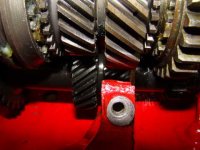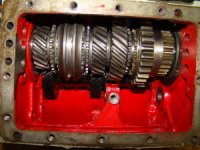Johnny
Darth Vader
Offline
Finished assembling the main gearset in my BJ7 and after installing the selector forks and shafts discoverd I can no longer shift into 3rd or 4th gear? I have the transmission out of the car and sitting on my workbench and am in the process of making sure I can shift manually all gears. I replaced the lay gear, reverse gear, and 1st gear with hub. All those work super smooth now but when trying 3rd or 4th, no luck. removed the (3rd/4th) shaft thinking it could be binding, nope, it's something inside the sliding hub. Oh, I also replaced all 3 baulk rings/synchros. I'm thinking the new synchros are preventing the hub from sliding. Any other ideas I'm overlooking? Has anyone else had this problem? Reluctantly, I now have to remove the gear set and replace the new baulk rings with the originals and try that. I thought I'd ask here first though. Any ideas? :confuse:
Oh, I installed the 3rd/4th rings facing each other (you know the points facing the center of the hub, I think thats correct.
Oh, I installed the 3rd/4th rings facing each other (you know the points facing the center of the hub, I think thats correct.

 Hi Guest!
Hi Guest!

 smilie in place of the real @
smilie in place of the real @
 Pretty Please - add it to our Events forum(s) and add to the calendar! >>
Pretty Please - add it to our Events forum(s) and add to the calendar! >> 











 I found the problem and the problem was ME! If you look at your photos (6th from the top) you'll notice the inner hub has a NOSE pointing up. That part goes into the driven gear in the front. I had it reversed. I'm only glad that in fact it wasn't able to shift into 3rd or 4th, even with difficulty, I may have forgotten about it until I had the transmission in the car. So, all I did was with the case in a vise (Nose part down) was lift out the rear main gear cluster, flip over the 3rd/4th hubs with the longer nose part down into the driven gear and voila! All works just fine now. With plenty of grease in the shaft even the roller pins stayed put when I lifted it out. BTW I discovered when first installing the main gear cluster into the driven gear in front, if you place the rollers with lots of grease, and secured with two rubber bands, around the main shaft you can easily lower the gear set down into the driven gear by yourself pretty easily.
I found the problem and the problem was ME! If you look at your photos (6th from the top) you'll notice the inner hub has a NOSE pointing up. That part goes into the driven gear in the front. I had it reversed. I'm only glad that in fact it wasn't able to shift into 3rd or 4th, even with difficulty, I may have forgotten about it until I had the transmission in the car. So, all I did was with the case in a vise (Nose part down) was lift out the rear main gear cluster, flip over the 3rd/4th hubs with the longer nose part down into the driven gear and voila! All works just fine now. With plenty of grease in the shaft even the roller pins stayed put when I lifted it out. BTW I discovered when first installing the main gear cluster into the driven gear in front, if you place the rollers with lots of grease, and secured with two rubber bands, around the main shaft you can easily lower the gear set down into the driven gear by yourself pretty easily.





 Many thanks Randy but not necessary to measure etc. From your excellent photo I can count 16 coils, the length isn't too hard to determine. A fellow club member has some springs left over I can borrow. Thanks for the offer though.
Many thanks Randy but not necessary to measure etc. From your excellent photo I can count 16 coils, the length isn't too hard to determine. A fellow club member has some springs left over I can borrow. Thanks for the offer though. Many thanks for all your help.
Many thanks for all your help. Okay, this is the final response to this thread and here's what I've learned, in a nutshell.
Okay, this is the final response to this thread and here's what I've learned, in a nutshell.